《英语报刊选读》期末复习指导
《英语报刊选读》期末考试试卷附答案
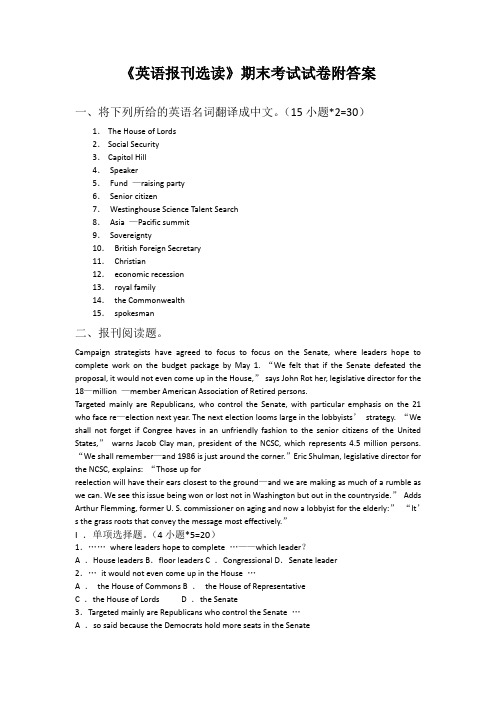
《英语报刊选读》期末考试试卷附答案一、将下列所给的英语名词翻译成中文。
(15小题*2=30)1.The House of Lords2.Social Security3.Capitol Hill4.Speaker5.Fund —raising party6.Senior citizen7.Westinghouse Science Talent Search8.Asia —Pacific summit9.Sovereignty10.British Foreign Secretary11.Christian12.economic recession13.royal family14.the Commonwealth15.spokesman二、报刊阅读题。
Campaign strategists have agreed to focus to focus on the Senate, where leaders hope to complete work on the budget package by May 1. “We felt that if the Senate defeated the proposal, it would not even come up in the House,”says John Rot her, legislative director for the 18—million —member American Association of Retired persons.Targeted mainly are Republicans, who control the Senate, with particular emphasis on the 21 who face re—election next year. The next election looms large in the lobbyists’strategy. “We shall not forget if Congree haves in an unfriendly fashion to the senior citizens of the United States,”warns Jacob Clay man, president of the NCSC, which represents 4.5 million persons. “We shall remember—and 1986 is just around the corner.”Eric Shulman, legislative director for the NCSC, explains: “Those up forreelection will have their ears closest to the ground—and we are making as much of a rumble as we can. We see this issue being won or lost not in Washington but out in the countryside.”Adds Arthur Flemming, former U. S. commissioner on aging and now a lobbyist for the elderly:”“It’s the grass roots that convey the message most effectively.”I .单项选择题。
英语报刊选读导学
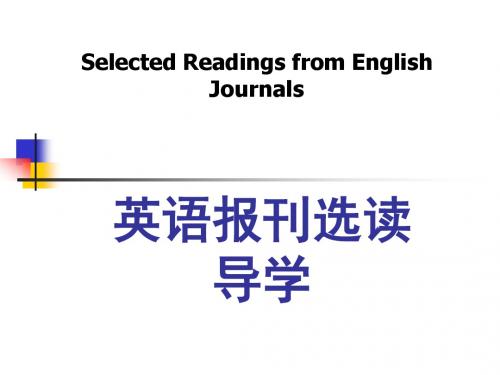
(八)资料来源
国内出版的英语报刊: China Daily; 2lst Century; Beijing Review; China Today
(八)资料来源
国外出版的英语报纸 International Herald Tribune; USA Today; The New York Times; The Washington Post; The Wall Street Journal; the Los Angeles Times; The Boston Globe; The Christian Science Monitor; The Harvard Crimson; The Financial Times; The Guardian
第五、报刊语言。课程联系每篇文章对报刊语言的特 点加以介绍,涉及诸如标题、篇章、用词、句法、修辞 和文体等方面。这些语言只是为学生提高英美报刊的水 平铺平了道路。 第六、课文注释、课文导读、词汇与短语以及译文。 为了帮助学生理解课文,本课程针对课文中的语言难点 提供了较为详细的注释,这些注释语言精当,释义准确 。课程考虑到了学生的英语现阶段水平特点,为此认为 有必要在每篇课文后面附上译文,词汇与短语解释,以 方便和增进学生对课文的理解。 第七、课文插图、音像资料。为了增加学生的学习兴 趣和报刊方面的知识。为了使课程呈现更多的网络课程 优势。本课程结合每篇文章的内容和所选报刊的特征适 当地加进一些插图、音像资料。这些插图和音像资料, 生动有趣地反映了文章内容的特点,既与内容密切结合 ,又反映了当今时政内容,也为学生在繁忙的学习之余 创造了休闲的环境。
英语报刊选读导学
美英报刊文章阅读课程期末复习指导
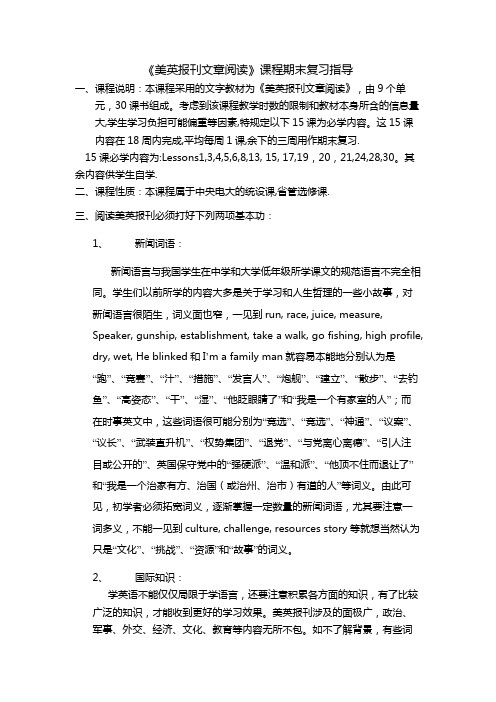
《美英报刊文章阅读》课程期末复习指导一、课程说明:本课程采用的文字教材为《美英报刊文章阅读》,由9个单元,30课书组成。
考虑到该课程教学时数的限制和教材本身所含的信息量大,学生学习负担可能偏重等因素,特规定以下15课为必学内容。
这15课内容在18周内完成,平均每周1课,余下的三周用作期末复习.15课必学内容为:Lessons1,3,4,5,6,8,13, 15, 17,19,20,21,24,28,30。
其余内容供学生自学.二、课程性质:本课程属于中央电大的统设课,省管选修课.三、阅读美英报刊必须打好下列两项基本功:1、新闻词语:新闻语言与我国学生在中学和大学低年级所学课文的规范语言不完全相同。
学生们以前所学的内容大多是关于学习和人生哲理的一些小故事,对新闻语言很陌生,词义面也窄,一见到run, race, juice, measure,Speaker, gunship, establishment, take a walk, go fishing, high profile, dry, wet, He blinked和I’m a family man就容易本能地分别认为是“跑”、“竞赛”、“汁”、“措施”、“发言人”、“炮舰”、“建立”、“散步”、“去钓鱼”、“高姿态”、“干”、“湿”、“他眨眼睛了”和“我是一个有家室的人”;而在时事英文中,这些词语很可能分别为“竞选”、“竞选”、“神通”、“议案”、“议长”、“武装直升机”、“权势集团”、“退党”、“与党离心离德”、“引人注目或公开的”、英国保守党中的“强硬派”、“温和派”、“他顶不住而退让了”和“我是一个治家有方、治国(或治州、治市)有道的人”等词义。
由此可见,初学者必须拓宽词义,逐渐掌握一定数量的新闻词语,尤其要注意一词多义,不能一见到culture, challenge, resources story等就想当然认为只是“文化”、“挑战”、“资源”和“故事”的词义。
英语报刊选读复习资料
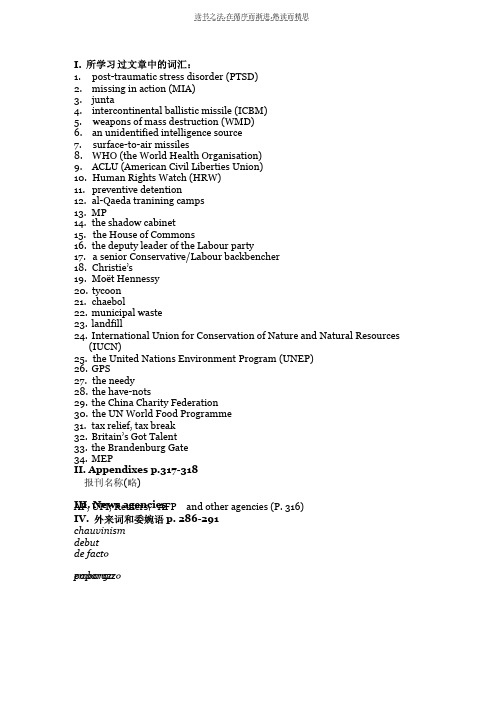
读书之法,在循序而渐进,熟读而精思熟读而精思I. 所学习过文章中的词汇:1.post-traumatic stress disorder (PTSD)2.missing in action (MIA)3.junta4.intercontinental ballistic missile (ICBM)5.weapons of mass destruction (WMD)6.an unidentified intelligence source7.surface-to-air missiles8.WHO (the World Health Organisation)9.ACLU (American Civil Liberties Union)10.Human Rights Watch (HRW)11.preventive detention12.al-Qaeda tranining camps13.MP14.the shadow cabinet15.the House of Commons16.the deputy leader of the Labour party17. a senior Conservative/Labour backbencher18.Christie’st HennessyMoët Hennessy19.Moë20.tycoon21.chaebol22.municipal wastendfill24.International Union for Conservation of Nature and Natural Resources(IUCN)25.the United Nations Environment Program (UNEP)26.GPS27.the needy28.the have-nots29.the China Charity Federation30.the UN World Food Programme31.tax relief, tax breaks Got TalentBritain’s Got Talent32.Britain’33.the Brandenburg Gate34.MEPII. Appendixes p.317-318报刊名称(略)III. News agenciesAP, UPI, Reuters,AFP and other agencies (P. 316)IV. 外来词和委婉语p. 286-291chauvinismdebutde factoembargopaparazzo读书之法,在循序而渐进,熟读而精思熟读而精思per capitade luxethe needythe have-notsthe well-preserved menpreemptive actionwelfare motherV. 表示消息来源的词语p. 252-253authoritative sourcesdiplomatic sourcesan unidentified sourceaccording to an anonymous sourceVI. 时新词 p. 184-185brain draincrunchtechnicallyinfotainmentironicallylooking-glassmom-and-poppink slipshowcasevidiotVII. 缩写词 p.128-129WWFEUGMGOPGPSIAEANASANYSEPOWVIII. 标题语法特征(p.97-100)略IX. 段落翻译:所讲授文章的部分段落和翻译练习中的三段,如以下段落。
《国际商务英语报刊选读》复习提纲
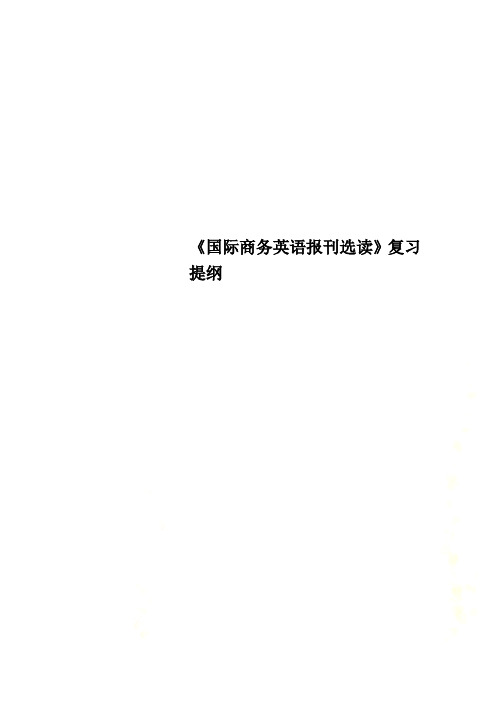
《国际商务英语报刊选读》复习提纲《国际商务英语报刊选读》复习提纲一、词汇词组(英翻中)job title 职别personnel manager 人事主管packaging 包装marketing director销售主管publicity controller 宣传主管managing director 常务董事layout 布局,安排,版面设计house style 印刷风格,独特风格,排字风格letterhead 信头logo 专用标记,标记,商标records for the files 文件记录trade exhibition 商品交易展览会company stand 公司展位delivery date 交货日期printed matter 印刷品relative merits 优缺点head office 总公司board 董事会health and safety provisions 健康与安全规定Bill of Lading 提货单Sea Waybill 海运单Air Waybill 空运单Shipping Note / Shipment Advice 装船通知单Dangerous Goods Note 危险物品通知单Certificate of Insurance 保险证明order book 订货簿shipping date 船期,装船日期money-back warranty 退款保证Samples of Merchandise 货物样品public relation 公共关系in good shape 完整无损,处于良好状态,健康情况良好sole supplier 唯一供给者tradejournal 行业杂志yellow page 电话黄页confirmed irrevocable letter of credit 不可撤销的保兑的信用证import license 进口许可证special introductory price 新产品特价bill of exchange 汇票house bills 公司汇票inventory position (BR. stock position)库存水平interest charges 利息费用bad debt 呆账(收不回的账)debt collection agency 债务托收代理trade & bank reference 银行征信(银行提供有关商号信誉等情况)pay-back date 付费日期business card 名片二、请根据给出的汉语词义写出对应的英语词。
年秋季学期英语报刊选读课程期末复习指导.doc
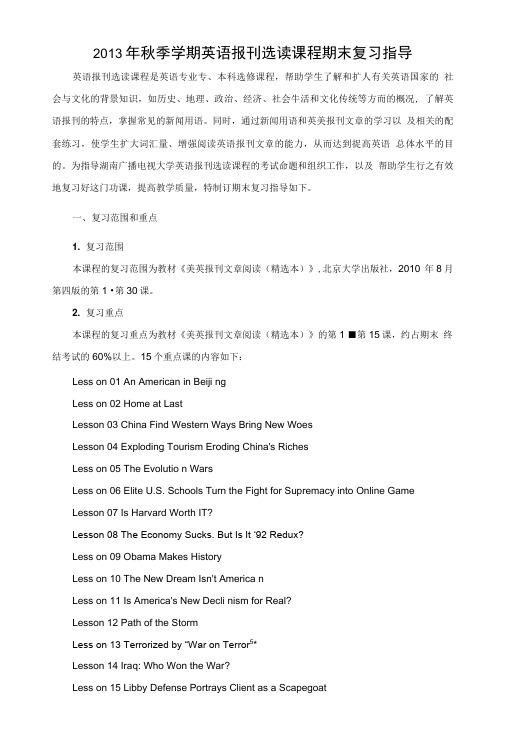
2013年秋季学期英语报刊选读课程期末复习指导英语报刊选读课程是英语专业专、本科选修课程,帮助学生了解和扩人有关英语国家的社会与文化的背景知识,如历史、地理、政治、经济、社会牛活和文化传统等方而的概况, 了解英语报刊的特点,掌握常见的新闻用语。
同时,通过新闻用语和英美报刊文章的学习以及相关的配套练习,使学生扩大词汇量、增强阅读英语报刊文章的能力,从而达到捉高英语总体水平的目的。
为指导湖南广播电视大学英语报刊选读课程的考试命题和组织工作,以及帮助学生行之有效地复习好这门功课,提高教学质量,特制订期末复习指导如下。
一、复习范围和重点1. 复习范围本课程的复习范围为教材《美英报刊文章阅读(精选本)》,北京大学出版社,2010 年8月第四版的第1 •第30课。
2. 复习重点本课程的复习重点为教材《美英报刊文章阅读(精选本)》的第1 ■第15课,约占期末终结考试的60%以上。
15个重点课的内容如下:Less on 01 An American in Beiji ngLess on 02 Home at LastLesson 03 China Find Western Ways Bring New WoesLesson 04 Exploding Tourism Eroding China's RichesLess on 05 The Evolutio n WarsLess on 06 Elite U.S. Schools Turn the Fight for Supremacy into Online GameLesson 07 Is Harvard Worth IT?Lesson 08 The Economy Sucks. But Is It ‘92 Redux?Less on 09 Obama Makes HistoryLess on 10 The New Dream Isn't America nLess on 11 Is America's New Decli nism for Real?Lesson 12 Path of the StormLess on 13 Terrorized by “War on Terror5*Lesson 14 Iraq: Who Won the War?Less on 15 Libby Defense Portrays Client as a Scapegoat二、考核说明1.考核对象湖南广播电视大学(开放教冇)英语专业专、木科的学生。
《英语报刊阅读》课程考核说明及复习资料
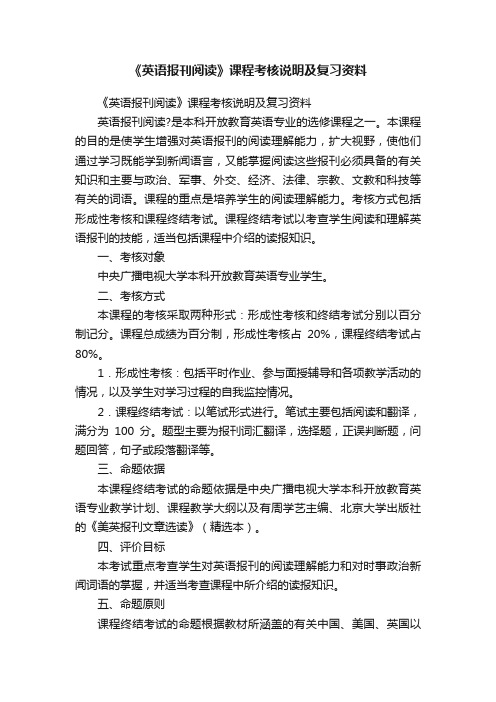
《英语报刊阅读》课程考核说明及复习资料《英语报刊阅读》课程考核说明及复习资料英语报刊阅读?是本科开放教育英语专业的选修课程之一。
本课程的目的是使学生增强对英语报刊的阅读理解能力,扩大视野,使他们通过学习既能学到新闻语言,又能掌握阅读这些报刊必须具备的有关知识和主要与政治、军事、外交、经济、法律、宗教、文教和科技等有关的词语。
课程的重点是培养学生的阅读理解能力。
考核方式包括形成性考核和课程终结考试。
课程终结考试以考查学生阅读和理解英语报刊的技能,适当包括课程中介绍的读报知识。
一、考核对象中央广播电视大学本科开放教育英语专业学生。
二、考核方式本课程的考核采取两种形式:形成性考核和终结考试分别以百分制记分。
课程总成绩为百分制,形成性考核占20%,课程终结考试占80%。
1.形成性考核:包括平时作业、参与面授辅导和各项教学活动的情况,以及学生对学习过程的自我监控情况。
2.课程终结考试:以笔试形式进行。
笔试主要包括阅读和翻译,满分为100分。
题型主要为报刊词汇翻译,选择题,正误判断题,问题回答,句子或段落翻译等。
三、命题依据本课程终结考试的命题依据是中央广播电视大学本科开放教育英语专业教学计划、课程教学大纲以及有周学艺主编、北京大学出版社的《美英报刊文章选读》(精选本)。
四、评价目标本考试重点考查学生对英语报刊的阅读理解能力和对时事政治新闻词语的掌握,并适当考查课程中所介绍的读报知识。
五、命题原则课程终结考试的命题根据教材所涵盖的有关中国、美国、英国以及亚洲的新闻内容以及与教材难度相当阅读技能,涉及教材内容不少于60%。
六、考试要求本课程终结考试为半开卷考试,除有关规定允许携带的物品外,考生不得携带其他任何形式的参考资料和电子读物或工具。
七、题型与复习资料(见附件)附件1《英语报刊选读》期末考试题型一、将下列报刊杂志名译成中文或英文。
二、将下列词组译为中文。
三、选择正确的项目替换划线部分的内容。
(词汇替换)四、阅读理解。
英语报刊选读复习要点

课程:英语报刊选读复习要点(最新版)熟悉下列英语报刊高频率词汇的含义In Mediaback issue, bulletin, canned copy, censorship, checkbook journalism, cold news, development stories, dope story, exclusive, breaking news, catchpenny, brief, broad sheet paper, caption, cover story, editor’s not es (Eds) ,flash, follow-up story, newscast, publicity, puff pieces, personal profile, round-up/wrap-up, running stories, social event features, spot news, wire service/news agency, update, deep throatIn Politicsriot police, the Bush administration, Saddam regime, rogue state, Axis of evil, Donkey, Elephant, Al-Qaeda, cold war mentality, empty-nest syndrome, Femlib, low profile, news blackout, sexism, upper, dove, hawk, police state, pocket vetoIn Metro Life dust storm/ sand storm, public hazard, fat farm, visual pollution, midriff, bug, edp crimes, domestic violence, occupational disease, makeover nation, Internet hookups, gay marriage, B-schoolIn Military Affairsbeam weapons, blanket bombing, MIA (missing in action), POW, war games, non-proliferation drive, bloodless coup, scud missile, military coup, military presence, stealth bomber, honey trap, weapon of mass destruction, coalition forces, checkbook participation, talkman, stealth fighters, decapitationIn Medicineeuthanasia或mercy killing/painless death, industrial disease, liposuction, vanity surgery, hypertensionIn Business and EconomyEuroland, debt chain, buy-out, equity joint venture, job-hopper, hardball, consumer price index (CPI), kickback, knockout product, scalper, cash cow, ATM (Automatic Teller Machine), Gate’s LawIn Science & Technologycanned software, cutting edge, g-force, info highway, computernik,In Film and TVbox office income/record/value, premiere /debut, trailer, show biz, animation, block-buster, paparazzo , rating , sitcom , soundtrack , extra Proper NounsWhite House, Capitol Hill, Buckingham, Downing Street No.10, Fleet Street, Pentagon, Wall Street, Broadway, Elysee, Kremlin, Hollywood, Silicon ValleyGreen Berets, Blue Berets, Iron Lady, Iron Curtain, First Lady Loanwordspersona non grata, glasnost, per capita, rapport, bloc, tsunami, tycoon, status quo, De factoa wait-and–see attitude, the life-and–death issue, the hit-and-run tactics, ready-to-eat foodThe four social functions of the media: surveillance, interpretation, transmit values, entertainment The Definition of JournalismDefinition of News and ingredients/elements of news News value/the newsworthinessPublic interest, Criteria for Newsworthiness:News value determiners²Timeliness.²Impact or Consequence or Importance²Prominence or Eminence²Proximity or closeness/ nearness²Conflict²The Unusual or the Bizarreness / Weirdness²Currency²NecessityNews ClassificationHard NewsSoft NewsFeaturescommentaries and columnspositive coveragenegative coverageneutral coveragemuckrakingThe headlineThe grammar of headlines:tenses, voices, Omission/Ellipsis, Punctuations, abbreviations各种机构、重要的国际组织名称的缩写常用缩写Important International Organizations, 要积累和熟记, E.g.CIA ( Central Intelligence Agency)FBI (Federal Bureau of Investigation),PLO,OPEC, ApecIMF (International Monetary Fund), WHOATM- Automatic Teller Machine CEO-Chief Executive OfficerCFO-Chief financial OfficerCNN-Cable News Networks Copter-helicopterCTO-Chief Technology Officer CTV-Cable TVD-dayDJ-disc jockeyDJ-Dow Jones & Co.GE-General ElectricsGM-General MotorsGMS-Global Positioning SystemHKSAR-Hong Kong Special Administrative Region ICP-Internet Content ProviderIOUMart-marketMP- Member of ParliamentPM- Prime MinisterNMD-the National Missile Defense systemNYSE-New York Stock ExchangeOpec-Organization of Petroleum Exporting Countries PNTR-Permanent Normal Trade RelationsPOW-prisoner of warSIM-Subscribers’ Identification ModuleV-day- Victory DayVP-Vice PresidentLead and body of a news storyA direct lead A delayed leadInverted pyramid阅读材料中的内容(Selected Readings from Mainstream Newspapers & Magazines) 包括重点词汇:International Atomic Energy Agency (IAEA)denuclearizationthe terrorism blacklistIOC( the International Olympic Committee)human rights abusesAI (Amnesty International)BOCAG (Beijing Organizing Committee for the Olympic Games ) International Paralympics Committee (IPC)The Federal Reservehigh net worth individualsthe Guinness World Recordthe National Intelligence Councilthe National Counterintelligence ExecutiveIPCC (the United Nation’s Intergovernmental Panel on Climate Change) EU (the European Union)Met Office (the Meteorological Office)the Royal Geographical SocietyGreenpeacethe World Health OrganisationNGO (non-governmental organizations)civil societyGongoshardline policyNASCAR (National Association of Stock Car Auto Racing)Unifem (United Nations Development Fund for Women)GOPWFP (the UN World Food Program)Article 43 (page 85) Paragraphs 1 & 2cyber-censorshipAttribution:消息来源official sourcesa US State Department sourcewell-informed sourcepolice sourcesthe highest quartersthe quarters concerneddiplomatic quartersmilitary expertsdiplomatic observeran unidentified sourcea source who wants to remain anonymous a source speaking on condition of anonymity。
英语报刊阅读复习

英语报刊阅读复习英语报刊阅读复习一、重点单词:1、常用单词:aid=assist; helpalter=change or modifyask=inquireban=prohibit or forbidblast=explodebegin=commenceboost=increasecheck=examineclaim=cause the death of ...clash=disagree stronglycurb=control or restrictdip=decline or decreaseease=lessenend=terminateflay=criticizeflout=insultfoil=prevent fromgrill=investigategut=destroyhead=directhold=arrestaccord=agreement(协议)aid=assistance(帮助)aim=purpose(目的)arms= weapons (武器)blast=explosion(爆炸)body=committee, commission(委员会)clash=controversy; dispute(冲突)crash=collision(碰撞,坠毁)deal=agreement, transaction(协议,交易)envoy=ambassador(大使)fake=counterfeit(赝品,骗局)fete=celebration(庆祝(活动))feud=strong dispute(严重分歧)flop=failure(失败)freeze=stabilization((物价、工资等)冻结)gems=jewels (珠宝;首饰)nod=approval(许可,批准)pact=agreement, treaty(条约,协议)poll=election, public opinion poll(投票选举,民意测验)?probe=investigation(调查)pullout=withdrawal(撤退,撤离)rift=separation(隔离,分离)set=ready(准备)step=progress(进程,进步)strife=conflict(冲突,矛盾)talk=negotiation(谈判)ties=(diplomatic) relations((外交)关系)2、常见事物名称:Aids(艾滋病)获得性免疫功能丧失综合症(Acquired Immune Deficiency Syndrome ?UFO=Unidentified Flying Object DJI=Dow-Jones IndexCPI=Consumer Price IndexPR=Public RelationsSALT=Strategic Arms Limitation Talks(限制战略武器会谈)SDI=Strategic Defense Initiative(战略防御措施)GMT=Greenwich Mean TimeJV=Joint VentureIPR=Intellectual Property Rights3、职业、职务或职称的简称,如MP(议员)PM=Prime Minister(总理;首相)FM= Foreign Minister 外长; Finance Minister 财长DM= Defense Minister 国防部长GM=General Manager总经理CEO= Chief Executive Officer 首席执行官CFO= Chief Financial Officer 首席财务官CMO= Chief Market Officer 首席市场总监CTO= Chief Technology Office首席技术官COO= Chief Operating Officer 首席运营官VIP=Very Important Person贵宾;要人TP=Traffic Policeman交通警察PA=Personal Assistant私人助理pro=professional专业的,职业的rep=representative 代表Russ=Russia 俄罗斯sec=secretary秘书tech=technology技术4、特殊结构单词:1) 截头留尾:chute=parachute降落伞copter= helicopter 直升机Quake= earthquake 地震2)截取首尾,保留中间flu=influenza流感frige= refrigerator 冰箱Tec = detective 侦探Vic = convict 罪犯or victory胜利3)截去中间,保留首尾c…tee=committee委员会C…wealth=Commonwealth英联邦com…l=commercial(商业的,广告)gov?t= government 政府motel= motor hotel 汽车旅馆nat…l=national全国的telecast=television broadcast 电视广播4)不规则裁剪词Aussie=Australian澳大利亚人telly=television(电视机)Brunch=breakfast + lunch 早中餐ecopolitics=economic politics 政治经济N-test= Nuclear test 核试验pix=pictures(电影)L. America=Latin America 拉丁美洲N. Ireland=North Ireland 北爱尔兰S.Africa= South Africa 南非二、知识点1、Supreme Court of the United States---------------美国最高法院District Court-----------------------------------------------地方法院Claims Court-----------------------------------------------索赔法院Court of Appeals for the Federal Circuit----------联邦巡回上诉法院Court of International Trade---------------------------国际贸易法院Territorial Courts------------------------------------------属地法院Court of Military Appeals-------------------------------军事上诉法院Court of Veterans Appeals-----------------------------退伍军人上诉法院Administrative Office of the Courts-----------------法院行政管理局Federal Judicial Center----------------------------------联邦司法中心2、Elephant----The Republican PartyMost members are conservatives.Donkey------The Democratic PartyMost members are liberals.3、奥巴马是美国第56届、第44任和第43位总统关于“届”“任”“位”美国宪法规定,总统选举4年一次,总统任满4年为一届。
英语报刊选读复习

一、Phrase TranslationUnit 11、证券交易所stock market2、回顾或反思(过去)in restropect3、为……提供基础set the stage for4、毁灭性后果devastating consequences5、信息技术的繁荣发展the information-technology boom6、不予理睬ride roughshod over sth.7、在危险中at risk8、战斗力combat effectiveness9、武装力量the armed force10、相反,反之on the contrary11、国土安全homeland security12、交战状态state of war13、无辜的受害者innocent victims14、秘密警察secret police15、大规模杀伤性武器WMD/weapons of mass destruction16、干对某人(对手)有利的事play into the hands of sb.17、先发制人的军事行动pre-emptive military action18、对……口头支持或表面赞成pay lip service to sth.19、最后的手段 a last resort20、核扩散nuclear proliferationUnit 21、世界经济论坛Word Economic Form/WEF2、网络公司狂dotcom mania3、企业的社会责任corporate social responsibility4、递延补偿deferred compensation5、非政府组织non-government organization6、更不必说not to mention7、坚定的信念article of faith8、企业的慈善事业corporate philanthropy9、善举good works10、税负见面tax relief11、案例研究case study12、双赢的特性win-win characterUnit 41、死囚区death house/death row2、死刑capital punishment/death penalty3、有线电视cable television4、商会chamber of commerce5、刑事司法criminal justice6、死刑电椅electric chair7、管教警官correctional officers8、无论好坏for good or ill9、无法想象的暴力行为unthinkable acts of violence10、监狱博物馆the Prison MuseumUnit 61.宪法对同性婚姻的禁止 a constriction/ban on gay marriage2.关于基本民德的辩论 a debate about fundamental mores3.承认各自的婚姻法recognise each other’s marriage laws4.给同性恋者一些除婚姻以外的合法权益grant gays some legal rights short of marriage5.一个一个地驳斥这些论点reject these arguments one by one6.联邦制度的实施the operation of the federal system7.保证和延迟民主的实施guarantee or extend the operation of democracy8.妇女选举权women’s suffrage9.维护社会准则defend social norms10.国会两院三分之二的多数 a two-thirds majority in both houses of congress11.公会对立法者的压力public pressure on legislators12.进行一场更大的政治赌博take a bigger political gambleUnit 91.超高频电视ultrahigh frequency/UHF television2.电子游戏video games/ electric games/ E-games3.数码摄像机digital video camera/ DCI camcorder4.漂亮/时髦手机snazzy mobile/ cell phone/ handset5.便利店convenience store6.配件生产商accessories producer7.安全系统security system8.压缩光盘compressed disc/CD9.芯片组chipset10.电池能耗battery consumption11.巨大突破 a huge quantum leap12.自动售货机vending machine二、Sentence TranslationUnit 11. The destruction of the Twin Towers of the World Trade Center made a symbolic statement that reverberated around the world, and the fact that people could watch the event on their television sets endowed it with an emotional impact that no terrorist act had ever achieved before.世贸双子塔的毁灭,是一个象征性的声明,震动全球;而人们可以在电视上观看此事件又使得它对人们造成的情感冲击超过以往任何恐怖行为。
英语报刊选读复习资料整理

Sentence TranslationUnit 11.The destruction of the Twin Towers of the World Trade Center made a symbolic statement that reverberated around the world, and the fact that people could watch the event on their television sets endowed it with an emotional impact that no terrorist act had ever achieved before.世贸双子塔的毁灭,是一个象征性的声明,震动全球;而人们可以在电视上观看此事件又使得它对人们造成的情感冲击超过以往任何恐怖行为。
2.Even so, September 11 could not have changed the course of history to the extent that it has if President Bush had not responded to it the way he did. He declared war on terrorism, and under that guise implemented a radical foreign-policy agenda whose underlying principles predated the tragedy.即便如此,如果布什总统没有做出那种回应的话,9.11事件原本不可能达到如此的改变历史进程的程度。
他向恐怖主义宣战,并根据该幌子实施了激进的外教政策议程,其核心思想此前早已酝酿好3.Before September 11 the ideologues were hindered in implementing their strategy by two considerations: George W. Bush did not have a clear mandate (he became President by virtue of a single vote in the supreme Court ) , and America did not have a clearly defined enemy that would have justified a dramatic increase in military spending.9.11之前,理论家在执行他们的策略时受到阻碍,主要基于以下两方面的顾虑:布什没有一个明确的施政目标(他在最高法院凭借单票当选总统);美国没有一个明确的敌人以使军费开支急剧增加合理化。
英语报刊选读期末考试范围与重点
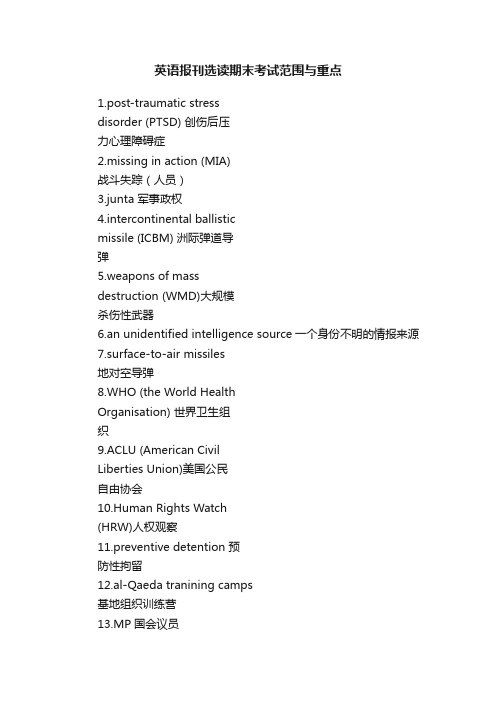
英语报刊选读期末考试范围与重点1.post-traumatic stressdisorder (PTSD) 创伤后压力心理障碍症2.missing in action (MIA)战斗失踪(人员)3.junta 军事政权4.intercontinental ballisticmissile (ICBM) 洲际弹道导弹5.weapons of massdestruction (WMD)大规模杀伤性武器6.an unidentified intelligence source一个身份不明的情报来源7.surface-to-air missiles地对空导弹8.WHO (the World HealthOrganisation) 世界卫生组织9.ACLU (American CivilLiberties Union)美国公民自由协会10.Human Rights Watch(HRW)人权观察11.preventive detention 预防性拘留12.al-Qaeda tranining camps基地组织训练营13.MP国会议员14.the shadow cabinet 影子内阁15.the House of Commons英国下议院又称平民院16.the deputy leader ofthe Labour party工党副领袖17. a seniorConservative/Labourbackbencher一位资深的保守党/劳工后座议员18.Christ ie’s佳士得19.Mo?t Hennessy酩悦轩尼诗20.tycoon (商界)大亨巨头21.chaebol 韩国大企业;韩国财阀22.municipal waste城市垃圾/doc/e515273562.html,ndfill 垃圾掩埋法,垃圾24.International Union forConservation of Natureand Natural Resources(IUCN) 世界自然保护联盟25.the United NationsEnvironment Program(UNEP)联合国环境规划署26.GPS 全球定位系统27.the needy贫穷的人28.the have-nots无产者29.the China CharityFederation中华慈善总会30.the UN World Food Programme联合国世界粮食计划31.tax relief, tax break税务减免,减税政策32.Britain’s Got T alent英国达人33.the Brandenburg Gate勃兰登堡门34.MEP 欧洲议会会员II. Appendixes p.317-318 III. News agencies (P. 316) AP, 美国联合通讯社UPI, 合众国际社Reuters,路透社AFP 法国新闻社,IV. 外来词和委婉语p. 286- 291Chauvinism 沙文主义Debut 首次登台演出,首映de facto 事实上,实际上,现存的embargo 禁运,禁止贸易paparazzo 狗仔队per capita 人均de luxe 高级的豪华的奢华的the needythe have-notsthe well-preserved men 保养有方的人preemptive action 先发制人的行动welfare mother 福利母亲接受救济的母亲V. 表示消息来源的词语p.252-253authoritative sources 权威人士diplomatic sources 外交人士an unidentified source 不愿透露姓名的人士according to an anonymous source 根据一位不愿透露姓名的人士VI. 时新词 p. 184-185brain drain 人才流失crunch 危机困境technically 确切的说,严格说,事实上infotainment 信息娱乐化资讯娱乐ironically 万万没料到,真巧,说来也怪looking-glass 完全颠倒的正好相反的mom-and-pop 夫妻店pink slip 解雇通知单showcase 展示表演亮相vidiot 不管什么电视节目和录像都看的人VII. 缩写词 p.128-129WWF 世界自然基金会)EU欧洲联盟(简称欧盟GMGOP美国共和党GPSIAEA联合国)国际原子能机构NASA美国国家航空航天局NYSE(美国)纽约证券交易所POW战俘VIII. 标题语法特征(p.97-100)IX. 段落翻译:所讲授文章的部分段落和翻译练习中的三段,如以下段落。
英语报刊选读复习资料
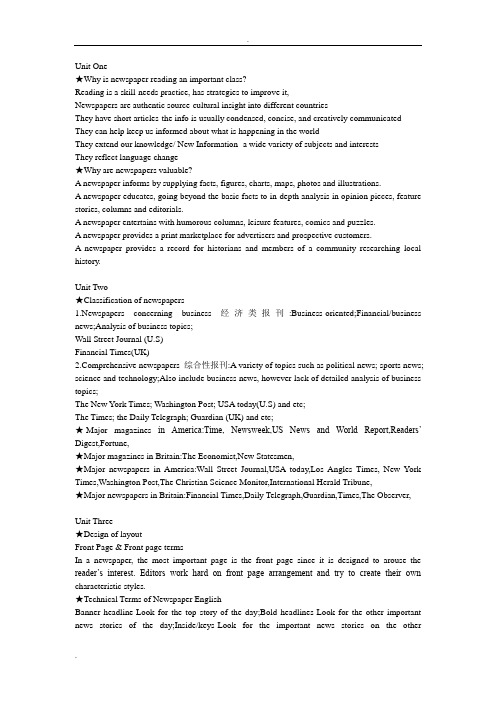
Unit One★Why is newspaper reading an important class?Reading is a skill-needs practice, has strategies to improve it,Newspapers are authentic source-cultural insight into different countriesThey have short articles-the info is usually condensed, concise, and creatively communicated They can help keep us informed about what is happening in the worldThey extend our knowledge/ New Information- a wide variety of subjects and interestsThey reflect language change★Why are newspapers valuable?A newspaper informs by supplying facts, figures, charts, maps, photos and illustrations.A newspaper educates, going beyond the basic facts to in-depth analysis in opinion pieces, feature stories, columns and editorials.A newspaper entertains with humorous columns, leisure features, comics and puzzles.A newspaper provides a print marketplace for advertisers and prospective customers.A newspaper provides a record for historians and members of a community researching local history.Unit Two★Classification of newspapers1.Newspapers concerning business经济类报刊:Business-oriented;Financial/business news;Analysis of business topics;Wall Street Journal (U.S)Financial Times(UK)prehensive newspapers 综合性报刊:A variety of topics such as political news; sports news; science and technology;Also include business news, however lack of detailed analysis of business topics;The New York Times; Washington Post; USA today(U.S) and etc;The Times; the Daily Telegraph; Guardian (UK) and etc;★Major magazines in America:Time, Newsweek,US News and World Report,Readers’ Digest,Fortune,★Major magazines in Britain:The Economist,New Statesmen,★Major newspapers in America:Wall Street Journal,USA today,Los Angles Times, New York Times,Washington Post,The Christian Science Monitor,International Herald Tribune,★Major newspapers in Britain:Financial Times,Daily Telegraph,Guardian,Times,The Observer,Unit Three★Design of layoutFront Page & Front page termsIn a newspaper, the most important page is the front page since it is designed to arouse the reader’s interest. Editors work hard on front page arrangement and try to create their own characteristic styles.★Technical Terms of Newspaper EnglishBanner headline-Look for the top story of the day;Bold headlines-Look for the other important news stories of the day;Inside/keys-Look for the important news stories on the otherpages;Sections-your interested news;Headline;Lead;(Headline\banner headline\bold headline\byline\cutline\dateline;News service;Lead\subject\news story(main body))Unit Four★There are three main types of journalismStraight news/spot news;Feature (news);Editorial & commentary/opinion;★Component of straight newsStraight news is mainly composed of the following five parts:1.Headline(标题)Headline is the first thing that catches your eye. It tries to tell the whole story in one sentence and then a smaller headline(sub-headline) tells more details of what happened.2.Sub-headline(副标题)3.Dateline(电头/日期行:日期,地点,通讯社)Dateline comes after sub-headline. It consists of three parts:1). the place where the news story was reported;2). The date when the news story was reported;3). the news agency;After the date are the letters standing for the news agencies(通讯社)a.AP(Associated Press) 美联社b.PA(press Association) 英国报纸联合社c. REUTER(Reuter’s News Agency)法国路透社d. BUP(British United Press, Ltd)英国合众社4.News lead(导语)Lead is the first paragraph of the whole news items;Lead tells all the important facts of the whole story in a content-packed sentence.It tells “five wives”—who, what, where, when, why and how about the event.Lead is also named as summary lead for it gives a comprehensive summary of news items5.The body of News story(正文)The body of news stories: The rest of the news item tells the details about the event, such as background, comments and etc.★Features of organizational structureSummary lead is commonly used in a straight news story, which gives a comprehensive summary of news items;A straight news story follows the inverted pyramid structure(the most important information comes first in the lead and the less important information such as background, comments come later in the body of the news);The lead of a straight news story usually answers five questions- “who”, “what”, “where”, “when”, “why” and“how”;Unit five★Importance and function of headlines:First of all, it summarizes the whole news story in one content-packed sentence so the hurried readers can get the gist of the story at a glance.Secondly, it draws the readers’ attention to the story. In this sense, headl ines are usually attractive so as to catch the readers’ eye.Thirdly, since headlines summarize the whole story, it can help the readers to evaluate the story so as to decide whether or not this news story is worth reading.★Types of newspaper headlines:A. Statement/summary (摘要式) :This kind of headline states the main topic of the whole news story. It is commonly used and is easy to understand. This kind of headline often appears in statement, that’s why it is named as statement sometimes.B. Question (设问式):However, most question headlines are not real questions. They are statements followed by a question mark. The question headline can either suggest a future possibility or some doubt about the truth or accuracy of the story:C. Quotation (引语式):This type of headline simply quotes what one says usually in direct speech so as to make the title vivid and lively. The quotation is usually from the spokesman, the eyewitnesses and the people involved in the news.D. Double headlines (双标题):The double headlines for the same news story are often used for important events:★Language features of newspaper headlinesLexical features:Preference for short & simple words-headline words ;Wide Use of Abbreviations &Acronyms Grammatical features:1.Frequent omission of function words: in particular, articles, conjunctions, prepositions, auxiliary verbs and pronouns:(1) Articles, (2) Auxiliaries,(3) The conjunction “and” is usually replaced witha comma,(4) The verb “say”, “said” are sometimes replaced with a colon “:” or quotation marks2. Simplification of tense:(1) Wide use of the simple present tense to describe something happening in the past as well as in the present,(2) The future tense is expressed with the infinitive to replace “will”, “shall”.Rhetorical features:Idioms are frequently used in English newspaper headlines so as to achieve vividness and meanwhile appeal to readers ;Slang;Colloquialism;proverbUnit Six★What is news lead?News lead refers to the first paragraph in a news story.★What is the language feature of news lead?Lead, like all English sentences is built around the subject and main verb.★How to understand news lead?As a result, if we can identify the subject and main verb, we will have a good understanding of news lead and the whole story.★How to understand news lead??Identify the subject and main verb first!!★What is prediction?Prediction means guessing what will happen next in the story.★Why should readers make prediction?It involves the readers in active interaction with the text by making them think about what they have read and what they will read next.★How to make prediction?Readers can make prediction based on the picture, title and the first paragraph; for instance, if you are reading a story about a murder, you can expect to find the answers to questions such as:Who was murdered?What was the reason for the murder?Has the murderer been caught? Readers can make prediction based on the picture, title and the first paragraph.Unit Seven★The body of news itemsWhat is it?The rest of news stories apart from news lead!It usually begins from 2nd paragraph of each news story!★Features of the body of news storiesImportant facts that the writer was unable to include in the lead;Specific details to answer readers’ questions;Statements and opinions by people involved in the story or by outside observers;Background information;New, but less important facts;It might be cut and omitted whenever there is no enough space for it.Unit Eight★Language features of news1.Emergence of news affixes and words: words concerning science and technology,words concerning politics, newly-coined words concerning other fields,2. Extension of words’ meanings: to borrow words from every work of life and extend its meaning.Words from the military field,3. Use of Euphemism:The substitution of an agreeable or inoffensive expression for one that suggests something unpleasant.e of metonymy: the substitution of the name of one thing for that of another closely associated with it.1) the name of an animal is borrowed to substitute a person or an organization.2) the name of a street or a building is used to stand for a well-known establishment or an office, which is located there.3) a well-known person is used to refer to something or somebody sharing the same feature.Unit Nine★Facts vs. opinionFactsA newspaper's primary purpose is to provide reliable information to its readers. To do so, a reporter must let the facts speak for themselves, must convey information fairly.?OpinionHowever, journalists all have their own social, political, economic and cultural background and thus tend to serve the interests of their own nations. Opinions and ideas do have a place in newspapers, in particular, on the editorial page for newspapers.★Bias by word choiceThe use of positive or negative words or words with a particular connotation can strongly influence the reader.Bias through statistics & crowd counts,Bias through use of names & titles, Bias through selections and omission,Bias through placement(Readers of papers judge first page stories to be more significant than those buried in the back. Where a story is placed, therefore, influences what a reader thinks about its importance.Bias by photos(Some pictures flatter a person, others make the person look unpleasant. Pictures can make a person look good, bad, sick, silly, etc. Which photos a newspaper chooses to run can heavily influence the public's perception of a person or event.) Bias by source control (To detect bias, always consider where the news item "comes from." Is the information supplied by a reporter, an eyewitness, police or fire officials, executives, or elected or appointed government officials?)★How is the source conveyed in news?a,News source is usua lly introduced by:Such verbs as “say”, “reveal”, “announce”, “remark”, “comment”;b. By the phrase “according to”;c. By the following passive constructions:It’s claimed that…★How to read a news story criticallyTip1: detect the words conveying bias:As a critical reader, you should pay attention to such words in news as adjectives, adverbs, nouns and verbs which might convey commendatory(positive) or derogatory(negative) meaning.Tip2: judge the source:As a reader, you must learn to judge whether the source is reliable.Is the source named? The reliability of a story is increased if the source is named since few people want to be known as liars.Where is the reporter? Check the dateline to see where the reporter was in relation to the news he is reporting.Tip3: have your own idea concerning a news storyUnit Ten★Opinion writingOpinion: articles that express the opinion of the newspaper’s editors or publishers; articles that reflect the views of columnists or well-known people; Read like an argumentation;Unlike straight news, they do not simply inform or entertain, but also try to persuade readers to accept W’s opinion;★Opinion writing includes the following major types!!Review;Column;Editorial;Letters to the editor;Editorial cartoons★ReviewReview is a description of books, performance, concerts, films, radio and television programs, lectures and art such as painting, dance and sculpture.Book review,Movie reviewUnit Eleven★What are editorial cartoons?Editorial cartoons are drawings or illustrations in the newspaper to help us think about current issues or to sway us toward the cartoonist’s point of view.★Elements of editorial cartoons:Symbolism: Using known concepts, emblems to represent larger ideas, people, organizations andevents.Dialogue bubbles: Used for speech, usually a circle around the words said by someone in a cartoon.Captions/labels: Used to make clear to readers what people and objects are being represented. Exaggeration/caricature: Emphasizing certain physical features or overstating an aspect of a problem. Many times without exaggeration and caricature, the cartoonist’s opinion might not be clear or the problem might not be obvious.Unit Twleve★The editorial★What is the editorial?articles that express the opinion of the newsp aper’s editors or publishers; Read like an argumentation;Unlike straight news, they do not simply inform or entertain, but also try to persuade readers to accept W’s opinion;★Elements of the editorialprimary purpose: They are intended to argue for or against a position and as well persuade the readers into W’s statement;Rhetorical structure(3 parts):Part I: Introduction paragraph: statement of thesis-put forward directly W’s position/put forward the issue in question;Part II: Body paragraphs: development of argumentsTopic sentence—supporting ideas/details/sub-conclusionPart III: Conclusion paragraph: reinforcement of thesis-sum up his main arguments and restate his position/sum up his main arguments and state his position;★Position of main ideas in the editorialThe main idea/W’s idea of the whole passage often appears in introduction paragraph (1st ) or/and conclusion (last paragraph);The location of the main idea/topic sentence of each paragraph is likely to be at the beginning, or the end of the passage and occasionally in the middle of the paragraph.Step1: Carefully read 1st paragraph and last paragraph for it might contain the main idea of the whole passage;Step2: Carefully read 1st & last sentence of each body paragraph for it might be the topic sentence which contains the main idea of each body paragraph;Step3: After having an understanding of the main idea & organizational structure, you can begin to answer the questions;。
英语报刊选读期末复习指导
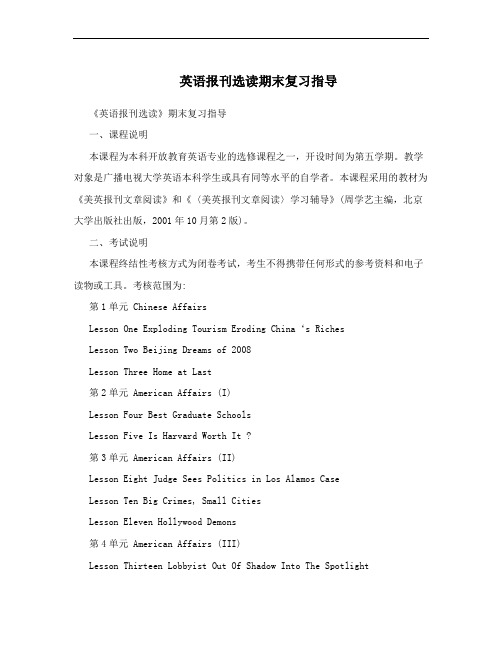
英语报刊选读期末复习指导《英语报刊选读》期末复习指导一、课程说明本课程为本科开放教育英语专业的选修课程之一,开设时间为第五学期。
教学对象是广播电视大学英语本科学生或具有同等水平的自学者。
本课程采用的教材为《美英报刊文章阅读》和《〈美英报刊文章阅读〉学习辅导》(周学艺主编,北京大学出版社出版,2001年10月第2版)。
二、考试说明本课程终结性考核方式为闭卷考试,考生不得携带任何形式的参考资料和电子读物或工具。
考核范围为:第1单元 Chinese AffairsLesson One Exp loding Tourism Eroding China‘s RichesLesson Two Beijing Dreams of 2008Lesson Three Home at Last第2单元 American Affairs (I)Lesson Four Best Graduate SchoolsLesson Five Is Harvard Worth It ?第3单元 American Affairs (II)Lesson Eight Judge Sees Politics in Los Alamos CaseLesson Ten Big Crimes, Small CitiesLesson Eleven Hollywood Demons第4单元 American Affairs (III)Lesson Thirteen Lobbyist Out Of Shadow Into The SpotlightLesson Fourteen The Rich Get Richer and Elected---1---1第5 单元 American Affairs (IV)Lesson Nineteen Free-talking and Fast Results第6单元 British AffairsLesson Twenty Why the Monarchy Must StayLesson Twenty-one Anything But Beef?第7单元 Asian AffairsLesson Twenty-four Giant on The Move第8单元 Australian, Brazilian, European & African AffairsLesson Twenty-eight Killing in the Name of GodLesson Twenty-nine Testimony to S. African Catharsis题型及分数比例:I.补上标题中省略或被代替的单词 (10%) II、阅读理解部分:选择题 (30%)正误判断题 (20%)问题回答 (20%)III. 翻译题 (20%)三、复习要点本考试重点考查学生对英语报刊的阅读理解能力和对时事政治新闻词语的掌握,并适当考查课程中所介绍的读报知识。
英语报刊阅读复习

英语报刊阅读复习英语报刊选读期末考试复习范围考试性质: 统考考试日期: 18周考试时间: 120分钟考试形式:闭卷,纸质考试(非机考)出题范围: 第I题从课本第1--8页出题,第V题出自教材之外,其余题目从第1、4、7、9、18、19、22、24、29课中出题)注意事项:所有答案必须写在答题纸上。
I. 是非判断题(10小题,每小题1分,共10分)从课本第1--8页出题。
Decide whether the following statements are true or false. If a statement is true according to the textbook, write T for its answer. If a statement is false according to the textbook, write F for its answer. (10 points, 1 point for each)e.g. (F) 1. The New York Times was founded in 1877.(T) 2. The Washington Post is a necessary newspaper for the Congressmen and government officials to read when they have their breakfast.报刊常识:1,the new york times :1851,美国第一大报,sulzberger家族,最多普利策奖,all the news that is fit to print ,越战,五角大楼the pentagon ['pentəɡ(ə)n五角形papers,东部势力集团,反映美国的外交动向,,执美国舆论牛耳,01年发网络版03年假新闻,日报排行32,the Washington post :1877,国会议员和政府官员早餐桌上少不了的一份报纸,水门事件,副总统spiro agnew 贿赂案,graham家族,排5 ,发周末版3,Los angeles times: 1881,西部老大,4,Use today:5,The wall street journal:6.International herald tribune;7.The Christian science monitor:8.time9.newsweek10.u.s.news & world report11.reader’s digest12.fortune13.Business week14.Far eastern economic review英国报刊1.the times:1785,读者为统治阶级,高级知识分子和工商金融界人士。
英美报刊选读(辅修) 解题技巧

英美报刊选读(辅修)解题技巧英美报刊选读(辅修)解题技巧一、阅读前的准备1.了解文章类型和主题在阅读前,首先要了解文章的类型和主题。
例如,新闻报道、社论、专栏文章等不同类型的文章有着不同的写作风格和表达方式,需要我们有针对性地进行阅读。
同时,了解文章的主题可以帮助我们更好地理解文章内容。
2.掌握必要的词汇和语法知识英美报刊选读中常用的词汇和语法结构是非常重要的。
如果我们不掌握这些基础知识,就会对理解文章造成困难。
因此,在阅读前可以先复习一些基础词汇和语法知识。
3.准备笔记工具在阅读时,我们需要记录一些重要信息,如关键词、作者观点等。
因此,在阅读前可以准备好笔记本或电子笔记工具。
二、阅读过程中的技巧1.快速浏览全文在开始详细阅读之前,可以先快速浏览全文,了解大致内容和结构,并标记出关键段落。
2.注意段落结构和标点符号英美报刊选读中,段落结构和标点符号是非常重要的。
段落结构可以帮助我们理解文章的逻辑结构,而标点符号则可以帮助我们掌握文章的语气和节奏。
3.注意关键词和短语在阅读过程中,我们要注意文章中出现的关键词和短语,这些词汇通常与文章主题密切相关。
同时,关键词和短语也有可能是文章作者的观点或态度的体现。
4.注意作者观点和态度英美报刊选读中,作者观点和态度是非常重要的。
我们需要通过分析作者使用的词汇、句子结构、修辞手法等来推断作者的观点和态度。
5.记录笔记在阅读过程中,我们需要记录一些重要信息。
例如,关键词、作者观点、证据等。
这些信息可以帮助我们更好地理解文章内容,并为后续写作提供素材。
三、阅读后的总结与反思1.归纳文章主旨在阅读完整篇文章后,我们需要归纳出文章的主旨,并总结出作者想要传达给读者的信息。
2.分析文章优缺点英美报刊选读中,有些文章存在一些优缺点。
例如,有些文章观点明确、论证充分,但表达方式欠缺灵活性;有些文章语言生动、形象,但缺乏实证数据。
我们需要对这些优缺点进行分析,并总结出自己的看法。
《英语报刊选读》期末题型注意事项理论知识考查范围50个缩略词范围201406
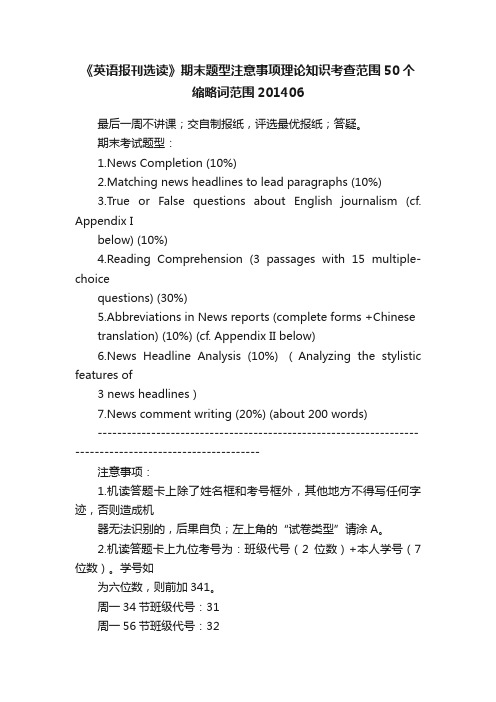
《英语报刊选读》期末题型注意事项理论知识考查范围50个缩略词范围201406最后一周不讲课;交自制报纸,评选最优报纸;答疑。
期末考试题型:1.News Completion (10%)2.Matching news headlines to lead paragraphs (10%)3.True or False questions about English journalism (cf. Appendix Ibelow) (10%)4.Reading Comprehension (3 passages with 15 multiple-choicequestions) (30%)5.Abbreviations in News reports (complete forms +Chinesetranslation) (10%) (cf. Appendix II below)6.News Headline Analysis (10%) (Analyzing the stylistic features of3 news headlines)7.News comment writing (20%) (about 200 words)--------------------------------------------------------------------------------------------------------注意事项:1.机读答题卡上除了姓名框和考号框外,其他地方不得写任何字迹,否则造成机器无法识别的,后果自负;左上角的“试卷类型”请涂A。
2.机读答题卡上九位考号为:班级代号(2位数)+本人学号(7位数)。
学号如为六位数,则前加341。
周一34节班级代号:31周一56节班级代号:32周四12节班级代号:33周四34节班级代号:343.选项为AB, BC, CD等的,在答题卡上就分别同时涂A和B, B和C,C和D等。
英语报刊选读期末考试题型
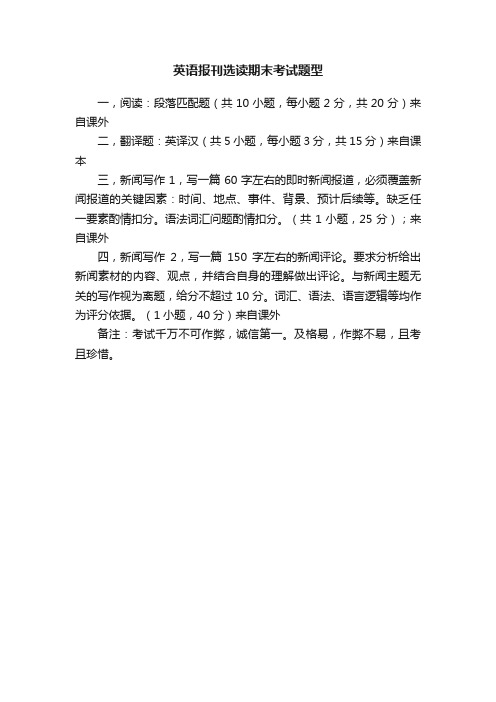
英语报刊选读期末考试题型
一,阅读:段落匹配题(共10小题,每小题2分,共20分)来自课外
二,翻译题:英译汉(共5小题,每小题3分,共15分)来自课本
三,新闻写作1,写一篇60字左右的即时新闻报道,必须覆盖新闻报道的关键因素:时间、地点、事件、背景、预计后续等。
缺乏任一要素酌情扣分。
语法词汇问题酌情扣分。
(共1小题,25分);来自课外
四,新闻写作2,写一篇150字左右的新闻评论。
要求分析给出新闻素材的内容、观点,并结合自身的理解做出评论。
与新闻主题无关的写作视为离题,给分不超过10分。
词汇、语法、语言逻辑等均作为评分依据。
(1小题,40分)来自课外
备注:考试千万不可作弊,诚信第一。
及格易,作弊不易,且考且珍惜。
- 1、下载文档前请自行甄别文档内容的完整性,平台不提供额外的编辑、内容补充、找答案等附加服务。
- 2、"仅部分预览"的文档,不可在线预览部分如存在完整性等问题,可反馈申请退款(可完整预览的文档不适用该条件!)。
- 3、如文档侵犯您的权益,请联系客服反馈,我们会尽快为您处理(人工客服工作时间:9:00-18:30)。
《英语报刊选读》期末复习指导一、课程说明本课程为本科开放教育英语专业的选修课程之一,开设时间为第五学期。
教学对象是广播电视大学英语本科学生或具有同等水平的自学者。
本课程采用的教材为《美英报刊文章阅读》和《〈美英报刊文章阅读〉学习辅导》(周学艺主编,北京大学出版社出版,2001年10月第2版)。
二、考试说明本课程终结性考核方式为闭卷考试,考生不得携带任何形式的参考资料和电子读物或工具。
考核范围为:第1单元Chinese AffairsLesson One Exploding Touris m Eroding China’s RichesLesson Two Beijing Dreams of 2008Lesson Three Home at Last第2单元American Affairs (I)Lesson Four Best Graduate SchoolsLesson Five Is Harvard Worth It ?第3单元American Affairs (II)Lesson Eight Judge Sees Politics in Los Alamos CaseLesson Ten Big Crimes, Small CitiesLesson Eleven Hollywood Demons第4单元American Affairs (III)Lesson Thirteen Lobbyist Out Of Shadow Into The SpotlightLesson Fourteen The Rich Get Richer and Elected---1---第5 单元American Affairs (IV)Lesson Nineteen Free-talking and Fast Results第6单元British AffairsLesson Twenty Why the Monarchy Must StayLesson Twenty-one Anything But Beef?第7单元Asian AffairsLesson Twenty-four Giant on The Move第8单元Australian, Brazilian, European & African AffairsLesson Twenty-eight Killing in the Name of GodLesson Twenty-nine Testimony to S. African Catharsis题型及分数比例:I.补上标题中省略或被代替的单词(10%)II、阅读理解部分:选择题(30%)正误判断题(20%)问题回答(20%)III. 翻译题(20%)三、复习要点本考试重点考查学生对英语报刊的阅读理解能力和对时事政治新闻词语的掌握,并适当考查课程中所介绍的读报知识。
课程终结考试的命题根据教材所涵盖的有关中国、美国、英国以及亚洲、非洲的新闻内容以及与教材难度相当阅读材料,涉及教材内容不少于40%。
复习要点:第一单元中有关中国的教育与文化的内容第二单元中有关美国教育的内容第三、四单元中涉及美国政治的内容第五单元中有关美国贸易的内容第六单元主要是有关英国政治的内容第七单元主要是有关印度的内容第八单元主要是有关非洲的宗教和种族歧视的内容四、综合复习题(试题范例)本科开放教育英语专业《英语报刊选读》考试模拟试题I. Reconstruct the messages of the following headlines of news stories: (10 points)Example: Italian Ex-Mayor Murdered---An Italian Ex-Mayor Is Murdered told not to exploit Tibet issue2.Rubin, Greenspan at odds3.Visitors flocking to Mao’s birth place4.Man quizzed after wife is knifed in sports storeII. Read the following passage and answer the Questions A 5-34 (30 points) and B 35-45 (20 points).Tuition Reform for Higher EducationChinese institutions of higher learning have quickened their pace of reform in recent years. Changing enrollment practices and higher tuition fees constitute and important part of the reform. Schools which once admitted students almost exclusively according to state plans are becoming more accepting of students sent by work groups for further training and those who pay their own fees.Regular universities and colleges plan to enroll about 786 200 students this year, up 158 200 or 25 percent over last year’s figure. Of these, 216 000, or 27.4 percent, will be sent by their work groups or will pay their own way.In the past, the state paid all tuition and school fees for university students, a matter of policy since New China was established in 1949. Although this practice guaranteed the supply of qualified personnel, it brought a heavy burden to the sate, hindering further development of higher education. Since higher education is non—compulsory education in China, to charge appropriate fees will help improve school facilities and expedite the development of education in this stage. As an added benefit, paying their own way will encourage students to study harder.The reform will take effect in two directions. State—financed students will begin paying part of the costs of their education, and more self—paying students will be accepted.In August 1989, under the direction of the State council, the State Education Commission, the Ministry of Finance and the Sate Price Bureau drew up stipulations concerning the amount of charges on tuition, accommodation and other expenses for students of institutions of higher learning. Beginning from that year, freshmen at regular universities and colleges and professional schools (including cadres taking special training courses and students working on a second degree) were charged 100 yuan (about us $17) each for their tuition fee, and this low charge is expected to be raised gradually. The figure was higher in special economic zones and economically developed regions such as Guangdong Province and Shanghai, but was capped at 300 yuan. Students living on campus paid about 20 yuan per year foraccommodation and the charge was slightly higher for better furnishing. Normal school students and those admitted on scholarships need only pay for accommodation. Reduced tuitions and fees are available to students in need of financial assistance, but accommodation expenses will remain the same.In June 1992, the State Education Commission, the Ministry of Finance and the State Price Bureau decided to allow regular institutions of higher education to set their own tuition rates and charges for accommodation, short—term training programs, correspondence courses and night school. These should be determined according to the needs of each school, the abilities of students to pay and general conditions in each area. The tuition for students in the sciences and engineering can range from 300 to 500 yuan per academic year. Liberal arts, history and economics students of the fine arts pay 400 to 600 yuan per year, and students of the fine arts 400 to 750 yuan. Statistics for 1992 show students paid an average of 340 yuan in tuition that year, only 5 percent of the real cost.Measures have been taken to limit the possible detrimental affects of rising tuition. Shanghai, for instance, exempts the children of revolutionary martyrs from paying tuition. And these costs may be reduced or waived for students with limited family financial support as their parents are either both dead or are receiving subsidies from their work units. Some colleges have also set up work—study programs to benefit students with financial difficultiesGuidelines concerning self—paying students were first set out in 1989. The State Education Commission, the Ministry of Finance and the State Price Bureau stipulated that these students should pay 80 percent of the cost of their education. Such students who live on campus pay the standard rate for accommodation and must cover their own medical expenses. The charge for each self—paying student averaged 2 000 yuan of the cost in 1992, or 30 percent of the cost. Charges for undergraduates and students of special colleges whose education is sponsored by work units, with payment coming either in part or in full from their units, are somewhat higher. Self—paying students are not assigned jobs by the state after graduation, whereas students sent by their units will return to them after graduating.Charges for correspondence courses and night school are equal to or slightly higher than those for full-time students enrolled according to the state plan.With their improvement of their living standards and the deepening of reform, people in general accept the changes in the tuition system. To facilitate the development of higher education, the increases in tuition rates will be more flexible and diversified. Student payments will be augmented by finding from the state, enterprises and funds raised from the public. Laws and regulations will by enacted to ensure steady progress, and overseas organizations and individuals are encouraged to set up and operate schools in China.--21st Century, Apr.20, 1992Reading ComprehensionCircle the letter that best suits the answer or completes the statement.5.Changing enrollment practices and higher tuition fees ____.A.pay an important part in the reformB.make up an important part of the reformC.include an important part of the reformD.hold an important part of the reform6.Regular universities and colleges plan to enroll about 786 200 students this year ____.A.which is the same as last years figureB.which is more than last year’s figure by 158 200C.which is 25 per cent over last year’s figureD.both B and C7.Among 786 200 students ____ will be sent by their work groups or will pay their own way.A. 158 200B. 21 600C. 27.4 per centD. 25 per cent8.Since New China was established, all tuition and school fees for university students ____A.Were paid by their work groupsB.Were paid by the students themselvesC.Were paid by the stateD.Were paid by the local government9.The policy which the state paid all tuition and school fees for university students ____.A.Brought lots of profits to the stateB.Was helpful to further development of higher educationC.Brought many advantages to the stateD.Brought expense and trouble to the state10.Which statement is not true?A.To charge appropriate fees will help improve school facilities.B.As an added benefit, paying their own way will encourage students to study harder.C.Higher education is compulsory education in China.D.Tuition reform for higher education will take effect in two directions.11.Stipulations concerning the amount of charges on tuition, accommodation and other expensesfor students of institutions of higher learning was drafted by ____.A.the State Education CommissionB.the State CouncilC.the universities and collegesD.the State Education Commission, the Ministry of Finance and the State Price Bureau12.The figure on tuition fee was higher in special economic zones and economically developed---5---13.regions, but was ____.A. fixed at 300 yuanB. limited in 300 yuanC. over 300 yuanD. much more than 300 yuan13.Students in need of financial assistance ____.A.can get a grantB.need only pay for accommodationC.can get support from the local governmentD. can enjoy reduced tuitions and fees14.According to the stipulations made by the State Education Commission, the Ministry of Financeand the State Price Bureau, the tuition for students in the sciences and engineering can ____.A.be changed between 300 and 500 yuan per academic yearB.be fixed at 300 or 500 yuan per yearC.be set at 400 or 600 yuan per yearD.be extended from 400 to 750 yuan per year15.The children of revolutionary martyrs in Shanghai ___.A.enjoy reduced tuitionB.enjoy free charge tuitionC.gain allowance from governmentD.receive subsidies from their parents’ work units16.Stipulations concerning self—paying students took effect in ____.A. 1989B. 1992C. 1990D. 199117.Charges for undergraduates and students of special colleges whose education is sponsored bywork units _____.A.are set at 2 000 yuan per yearB.are exempted 50 per cent from the whole cost of their educationC.are rather higherD.are exempted 30 percent18.Self—paying students, after their graduation, ____.A.will return to their unitsB.will be appointed to do some work by the stateC.are provided employments by the statD.are not assigned jobs by the state19.Which statement is true?A.The increases in tuition rates can not be changed easily.B.Students payment will be decreased by funding from the state and enterprises.ws and regulations will be made to ensure steady progress.D.People in general can’t accept the change in the tuition reform.VocabularyChoose the best answer to explain the meaning of the underlined word or phrase.20.Chinese institutions of higher learning have quickened their pace of reform in recent yearA. walkingB. stepC. footD. speed21.Changing enrollment practices and higher tuition fees constitute an important part of the reform.A.Make upB. establishC. holdD. complete22.Although this practice guaranteed the supply of qualified personnel, it brought a heavy burdento the state.A. it brought the state expense and troubleB.it brought the state sufferingC.it made the state involve in difficultiesD.it caused the state involved in troubles23. The reform will take effect in two directions.A. will take placeB. will come into forceC. will affectD. will have an influence24. The figure was higher in special economic zones and economically developed regions such asGuangdong, province and Shanghai, but was capped at 300 yuan.A.coveredB. aboutC. overD. much more than25. This Ministry of Finance and the State Price Bureau decided to allow regular institutions of highereducation to set their own tuition rates and charges for accommodation.A. decideB. fixC. put forwardD. Both A and B26. The tuition for students in the sciences and engineering can range from 300 to 500 yuan peracademic year.A.be charged between 300 and 500B.set at 300 or 500C.be decided at 300 or 500D.extend from 300 to 50027. Measures have been taken to limit the possible detrimental affects of rising tuition.A.determinedB. damageC. harmfulD. influential28. Shanghai, for instance, exempts the children of revolutionary martyrs from paying tuition.A.charges a little forB. makes free charge forC. reduces the charge forD. Both A and B29. And these costs may be reduced or waived for students with limited family financial support astheir parents are either both dead or are receiving subsidies from their work units.A. insisted onB. not enforcedC. chargedD. exempted30. Some colleges have also set up work—study programs to benefit students with financialdifficulties.A. helpB. give money toC. give profits toD. send allowance of money to---7---31. The State Educational Commission, the Ministry of Finance and the State Price Bureau stipulated that these students should pay 80 percent of the cost of their education.A.arrangedB. advocatedC. stated clearlyD. stimulated32. Such students who live on campus pay the standard rate for accommodation and must cover theirown medical expenses.A.includeB. exemptC. changeD. provide money for33. Self—paying students are not assigned jobs by the state after graduation, whereas students sent bytheir units will return to them after graduation.A.After graduation the state doesn’t give employments to the self—paying studentsB..After graduation, the state doesn’t appoint the self—paying students to do some workC.After graduation, the self-paying students are not going to apply for jobsD.All are wrong.34. To facilitate the development of higher education, the increases in tuition rates will be moreflexible and diversified.A.will be more easily bent and variousB.will be more limited and variousC.will be easily changed and in variety to adapt to new conditionsD.will be raised more than beforeB Endangered Trade(The Asian Wall Street Journal, Mar., 1999)Such is the special relationship between America and its NATO partners that while that alliance cooperates to bomb Serbian forces, the U.S. and the EU are managing a trade war against each other. Fortunately, no lives are at stake in the latter conflict. Yet if it spreads unchecked, the rest of the world is sure to feel the pain of it.It’s hard to decide whether the U.S. or Europe deserves the most contempt for expanding their trade war. The first fight, over bananas, is essentially a struggle between two fruit distributors with strong political connections. Now Washington and Brussels are escalating their battle over beef, with European farmers stooping to phony science in their claims that hormone-treated American beef is unsafe.In his first term in office, President Bill Clinton teamed up with the Republicans to push major free-trade liberalizations. Now, however, he seems bent on pursuing ‘level even if playing fields,’torpedoing the world economy. The latest salvo was fired this week, with the U.S. announcing it has targeted close to $1 billion of European products for 100% tariffs if the European Union doesn’t drop the hormone nonsense.The move follows an earlier announcement that the U.S. administration will fight Europe’s banana import regime by hitting a range of European goods with prohibitive tariffs. Add to this renewed American threats to raise the drawbridge to Russian, Japanese and Brazilian steel, as well as administration support for a congressional vote to ban Concorde flights from Europe in relation for EU threats to refuse landing rights to old-American planes retrofitted with noise reducing technology.Mr. Clinton sounded the protectionist battle cry in his January State of the Union address, where he vowed to fight for ‘a freer and fairer trading system for 21st century America.’ In the case of agriculture, when the respective lobbies on both sides of the Atlantic enter the fray, that translates into a sticky situation. On the whole, American farmers are major exporters. And U.S. farmers have a good case on beef hormones. But it is nonetheless dangerous for the U.S. to shut off $1 billion in trade.This is not to excuse the EU. The hormone argument is nonsense. The World Trade Organization has acknowledged as much, ordering the EU to allow imports of American meat by May 13. Brussels hasresponded by saying that it needs more time because European citizens, who supposedly don’t like hormones in their food, would rebel against their governments if American meat suddenly appeared on their store shelves.Were it not for the high stakes involved for both producers and consumers, the argument might be amusing. When governments curtail trade the global economy shrinks and for all the jobs ‘saved’by protections, there are a lot more lost. The Smoot-Hawley agricultural protections imposed by the U.S. Congress in the late 1920s certainly contributed to the Great Depression. Mr. Clinton may believe he is fighting the good fight. But we’ve never thought much of the kind of war where you pose even when you win.Judge whether the following statement are True or False:35. ( ) The Trade war between the U.S. and the EU has cost no lives but is equally dangerous.36. ( ) It’s very easy to decide who is to blame for expanding the trade war.37. ( ) The very beginning of the trade war suggests that it bears political significance.38. ( ) The author agrees that hormone-treated beef is harmful to one’s health.39. ( ) President Bill Clinton used to be a believer of free trade, but not now.40. ( ) Level playing fields ca do good to the world economy.41. ( ) Besides its trade war with the EU, the U.S. is also in conflict with Japan, Russia and Brazil.42 .( ) The author thinks that in the case of beef, the American farmers are justified.43. ( ) The author thinks that it is a right decision for the U.S. to shut off $1 billion in trade.44. ( ) The two sides have submitted the case of beef to the WTO for settlement.III. Read the following passage and answer Questions 45-49 (20 points)The Rich Get Richer and ElectedBy Steven V. RobertsSpecial to The New York TimesWASHINGTON, Sept. 23 –The House of Representatives, which prides itself on being “the people’s House.” Has been turning into a rich man’s club.The representatives newly elected in 1984 were almost four times as wealthy as the first-term lawmakers elected only six years before, according to a new study based one the members’ financial reports.Behind this remarkable a swing, the study says, are two main factors: a court decision that outlawed limits on what candidates could give to their own campaigns, and the enormous growth in the cost of pursuing a seat in Congress. As a result, it is increasingly difficult for candidates of modest means, particularly women, to mount successful challenges to entrenched office holders.One solution, the authors contend, is a system of public financing for campaigns, but Congress seems in no mood to change the political rules any time soon.“The lower chamber is going upper class,” said Mark Green, the president of The Democracy Project, a public policy institute based in New York. “But this evolution from a House of Representatives to a House of Lords denies the diversity of our democracy. It establishes a de facto property qualification for office that increasingly says: low and middle income need not apply.”The Democracy Project produced the study in cooperation with the United States Public Interest Research Group, a similar institute situated in Washington. But their research was not entirely theoretical. In 1980 Mr. Green was the unsuccessful Democratic candidate for Congress in New York’s 15th District, in Manhattan. The winner was Bill Green, one of the wealthiest members of Congress.Of Assets and MillionairesMembers of Congress must report their assets in broad categories, not exact numbers, so the figures in the study are not precise. But the minimum average wealth of the 43 lawmakers first elected last year was $251,292. Six years earlier, the 74 new members reported an average of only $41,358 in assets. With inflation figured in, the increase was almost 400 percent in real terms.Moreover, financial data on the class of 1978 indicated only one millionaire, William F. Clinger Jr., a Pennsylvania Republican. Last year’s newcomers included 15 possible millionaires, more than a third of the entire group. Topping the list was Joseph J. Dioguardi, a Westchester Republican, who listed assets of $1 million to $2.46 million.The main reason for the change, Mr. Green maintains, is the Supreme Court decision of 1976 in the case of Buckley V. Valeo. In that case, the Court ruled that limits mandated by Congress on the amount a candidate could give to his or her own campaign were an unconstitutional abridgment of individual rights. At the same time, the Court upheld limits on amounts contributed by outsiders.“Quite naturally”, Mr. Green said, “this puts a premium on personal wealth. The 43 Representatives newly elected in 1984 spent an average of $459,344; of that, $50,329 was their own money in an average case. Eight of the 43 spent more than $100,000 in personal funds but the clear leader was Tommy F. Robinson, an Arkansas Democrat, who contributed $441, 167 to his own campaign. Mr. DioGuardi was next with a personal donation of $210,000.The Senate Puts an even higher premium on wealth. Last year the average candidate for the Senate spent $2 million, and the roster of millionaires in the Senate is steadily growing.The second factor putting a premium on personal wealth, Mr. Green argues, is the rapid rise of political action committees. They tend to favor incumbents with their campaign contributions, and a result, Mr. Green says, is that it takes a wealthy challenger to make a race of things.One apparent effect is the obstacle this poses for women who run for Congress. While women in rapidly rising numbers are capturing local and state offices, their representation on the national level has stayed static. The class of 1984 included only two women: Helen D. Bentley of Maryland and JanMeyers of Kansas, both Republicans.“It is largely men who control wealth in America,” Mr. Green said, “and if wealth is a major variable in political success, that automatically means more men will run and win.”Fred Wertheimer, president of Common Cause, the public affairs lobby that studies campaign financing issues, summed up the situation this way: “Today, if you’re not personally wealthy, and you’re not willing to indebt yourself to the PAC’s, you face an uphill struggle just to get your message on the table.The authors of the study argue that some form of public financing for campaigns should be instituted. “Competition for public office should be based more upon merit than money,” asserted Gene Karpinski, executive director of the public interest research group.Mr. Wertheimer argues that “members of Congress know they have a national scandal on their hands”and are willing to consider public financing, or at least a total limit on PAC contributions. But the chances for change in the current system remain decidedly poor.Obviously the current occupants of Capitol Hill have kept their seats under the present rules, which clearly favor incumbents. Accordingly, Mr. Green maintains, Congress is still probably “several scandals away” from a serious push to change the campaign system.(From The New York Times, September 24, 1985)45. Why has the House of Representatives been changing into a rich man’s club or a House of Lords?46. In what way did the Court decision favor the wealthy candidates?47. Are women far behind men in getting Congressional offices? Please give an example for your answer.48. What role do political action committees play in a campaign for public office?49. According to the author of the study, on what basis should the political race for public office be placed?V. Translate the following into Chinese: (20%)How to negotiateThe US is an attractive market. Its business culture, which has brought the world “shareholder value” and “IPOs”, has been leading commercial thinking in recent years and will continue to do so. But whoever wants to succeed in the US needs to remember the rules of the game.US business is described by the lyrics of the song New York, New York: “If you can make it here, you can make it anywhere!”Yet a euphoric approach to business is by no means enough. Although business communication in the US is pleasant and easygoing, it is at the same time ruthlessly focused.Communicating is natural talent of Americans. When negotiating partners meet, the emphasis is on small talk and smiling. There is liberal use of a sense of humour that is more direct than it is in the UK.11If you give a talk in America, you should speak in a relaxed way and with plenty of jokes to capture your audience’s attention.《英语报刊选读》期末模拟试题参考答案I. 补上标题中省略或被代替的单词(每词分1分,共10分)1.The US is told not to exploit the Tibet issue2.Rubin and Greenspan are at odds3.Visitors are flocking to Mao’s birth place4. A man is quizzed after his wife is knifed in a sports storeII. 阅读理解A. 每小题1分,共30分5. B6. D7. C8.C9. D 10. C 11. D 12. B 13. D 14. A15. B 16. A 17. C 18. D 19. C 20. D 21.A 22. A 23. B 24. A25. B 26. A 27. C 28. B 29. D 30. A 31. C 32. D 33.B 34. CB.每小题2 分,共20分35. T 36. F 37. T 38. F 39. T40. F 41. T 42. T 43. F 44. TIII.每小题4分,共20分45.Because the House of Representatives is largely composed of wealthy men, and they get elected noton their merit, but on their money.46. The court decision outlawed limits on the amount that a candidate could give to his own campaign. At the same time it upheld limits on amounts contributed by outsiders.47. Yes. Take the Congressional election in 1984 for example, only two women got elected.---12---48. They play a very important role to help officeholders to get re-elected with campaign contributions.49. Some form of public financing should be taken. Competition for public office should be based more on merit than money.IV. 翻译20 分评分标准:17-20分,句子通顺,意思准确,基本术语几乎无错误。
